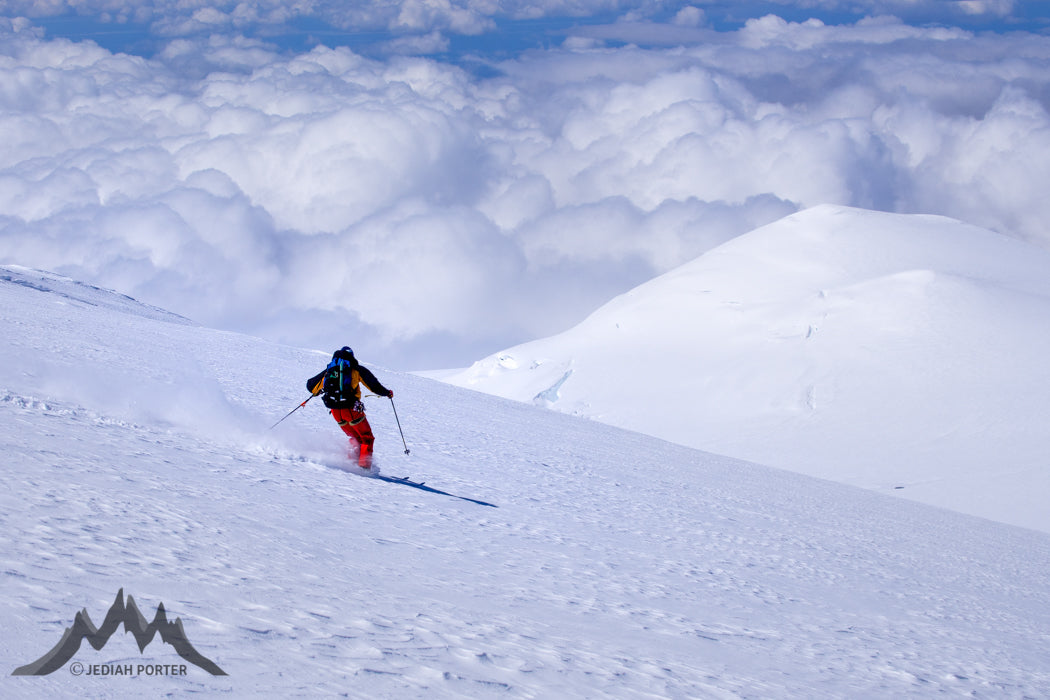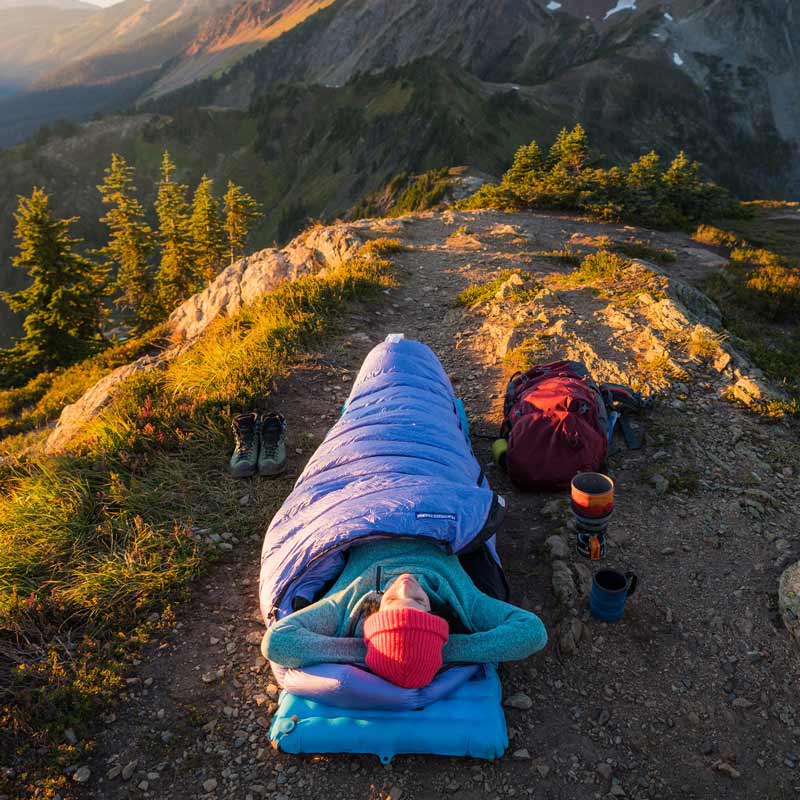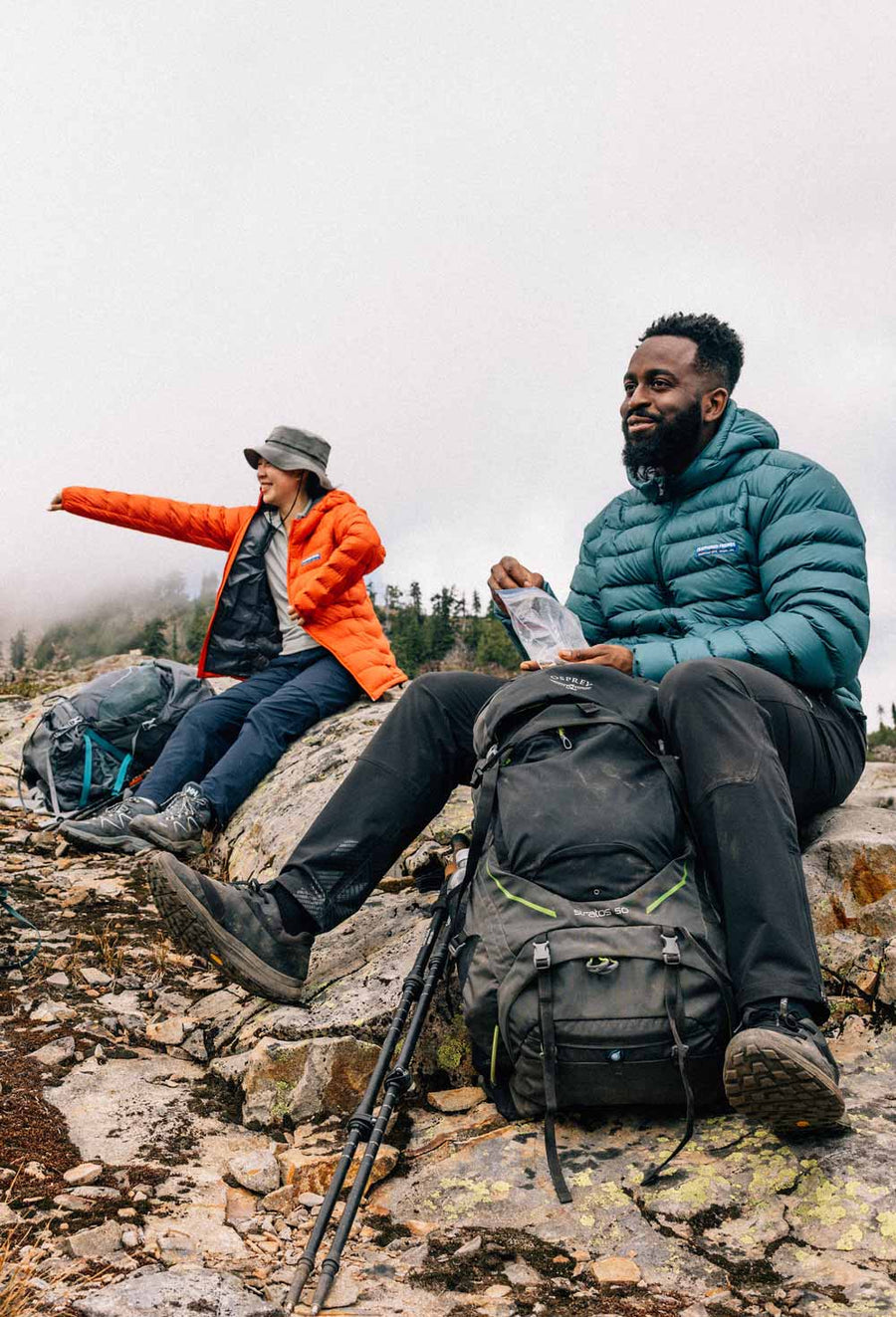Feathered Friends Blog
Himalaya climbing season is just around the corner and we are busy shipping down suits and jackets around the world. As those climbers prepare for their journeys, we wanted to share a trip report by Feathered Friends ambassador Erin Smart about her first trip to the Himalaya and attempted ski descent of Pumori last fall. Words by Erin Smart. Photographs by Erin and Benjamin Ribeyre.
With my crampons secure on the 55 degree slope, and my axes sunk in above me, I looked up to Benj a few meters above as he asked me “what do you think?” I knew what he was asking. I looked down at the steep icy slope below us, and at the bergschrund that was above a 100 meter ice cliff, and then I looked above us at the 1000m of steep snow above. I spent a minute gaging the “maybe” in my head, and thought of my brothers words from the previous days satellite phone call, “Only do it for you. Remember that no one cares.”
Paul had tried to climb Pumori before in 2011, but due to bad weather, his team didn’t get much farther than base camp. He recruited Benj in the spring, and I received my invitation to join shortly thereafter. Benj and I had been in the mountains a lot before, but we only had one mountain prep trip with the whole team before we left for Nepal. We climbed and skied the Tour Ronde in the Chamonix valley in October and the team got along great. The adventure was off to a great start.
Expedition report from prolific climber and alpinist, Jay Smith. Jay has been climbing for “longer than he cares to admit,” and put up nearly 2,000 new routes across the world. His climbing partner, Jim Donini, is another prolific man of the mountains who was president of the American Alpine Club from 2006 to 2009 and is known for his routes in Patagonia and Alaska. Words and images by Jay Smith.
Not all expeditions go as planned. Read on to see how these two experienced alpinists responded to adverse conditions and tough decisions.
Cerro San Lorenzo is the second highest peak in Patagonia. It lies at 47º south latitude, in-between the northern and southern Patagonia ice caps, the only ice caps (an ice mass covering less than 50,000 square kilometers) outside of the poles. At 12,170’ it is not particularly high, but do to it’s location, less than 50 linear miles from the Pacific, on the Chilean/Argentine border, it experiences some of the worst weather on the planet. Indeed, it’s 6 mile summit plateau, which is almost completely adorned with overhanging seracs and cornices, presents formidable obstacles which defend it’s 3 summits. Just to find safe passage between these is a challenge. That, coupled with atrocious winds that can easily exceed 100 mph sweeping the summit, makes it a very difficult mountain to attain by any route. Other than the normal route, a walk-up via glacier travel, there are only 2 other climbs on the mountain that have been completed, though many have been attempted.
Have you started training for that mountain yet? It has been two weeks since our last post, and it is already March!
Below are a few more tips to keep in mind as you try to get your body and mind ready to climb.
As before, be sure to consult with your physician before beginning any new activity. These posts are not a comprehensive training program, and don’t forget to learn and practice the necessary technical skills as well!
Words and photographs by Claire Giordano.
1. Simulate the climb with back-to-back training days
Will your climb be one day, two days, or three or more? Most of the volcanoes in Washington are two day climbs (unless you are a trail runner or doing a longer trip with multiple objectives and skill building lessons). This means our bodies must perform a few days in a row, and the best way to prepare for this is to do back-to-back training days or overnight backpacks.
Do you have some big mountain goals for 2017? If so, it’s already the middle of February and summer mountaineering season (in the states) will be here before you know it. Time to begin training.
Here are a few tips to think about as you start getting out there.
As always, be sure to consult with your physician before beginning any new training program. This post is not a comprehensive training program, but hopefully gives you some ideas. Don’t forget to learn and practice the necessary technical skills as well!
Words and photographs by Claire Giordano.
1. Start early, and ramp up slowly.
Climbing a mountain (such as Rainier) takes not only strength, but also excellent endurance. One of the most common routes, Disappointment Cleaver, requires you to carry a heavy pack (usually around 40 pounds if guided, more if your group is self supported) all way way to basecamp at 10,000 feet. Then, that night or the next, you drop the weight at camp and go even higher in your attempt to reach the summit. The combination of elevation and exertion for hours causes a lot of stress on the body.
A trip report from AMGA/IFMGA Mountain Guide Jediah Porter.

Human adventures are like caribou antlers; born soft and fuzzy with hope. Really, both start as just an idea, deep in one’s DNA. As they take shape, before they even take action, they are gentle and virtually unnoticeable. The promise of their power and prominence is there, but the scratched, hormonal, prideful reality is yet to be revealed.
For us, the climb and ski of Alaska’s Mount Sanford started as just a tiny, incubating idea in a teenager’s soul. In Wildsnow, the definitive tome on North American ski mountaineering, guru (and now mentor) Lou Dawson mentions the Sheep Glacier route on Mount Sanford as perhaps the ultimate mid-difficulty ski run on a giant peak. I stumbled across that literally 20 years ago, and the idea has simmered since then.
My wife Meagan and I booked some guiding work in Alaska in the spring of 2016, and looked to tack on a personal adventure. The time was right, the team was right, Mount Sanford was the call.











